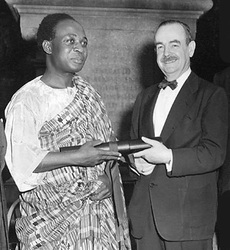
- Publications: The Life and works of W.E.B. Dubois by Daniel Agbeye Blawo (1998), post cards, books, studies on Pan Africanism and other souvenir items
- Facilities: Seminar facilities, souvenir shop, open air theatre, library and guest rooms.
- Opening Hours: 09:00 - 18:00 Hours Daily
- Dr. Kwame Nkrumah (1909-1972)
- Patrice Lumumba (1925-1961)
- Benjamin Nnamdi Azikewe (1904-1996)
- Ahmed Sekou Toure (1922-1984)
- Modibo Keita (1915-1977)
- Kenneth David Kaunda (1924- )
- Leopold Sedar Senghor (1906-2001)
- Marcus Mosiah Garvey (1887-1940)
- Dr. Kwame Nkrumah (1909-1972)
- George Padmore (1902-1960)
- Dr. W.E.B DuBois (1868-1963)
- Emperor Haile Selasie (1890-1974)
- Dr. K. Julius Nyerere (1922-1999)
- Dr. Kwame Nkrumah (1909-1972)
- Jomo Kenyatta (1891-1978)
- Paul Robeson (1898-1976)
- Malcolm X (1925-1965)
- Martin Luther King Jr (1926-1968)
- William Alphaeus Hunton (1903-1970)
- Andrew Young (1932- )
- Albert Tohn Luthuli (1898-1967)
- Chaka (1786-1836)
- Nelson Mandela (1918- )
- Edward Wilmot Blyden (1832-!912)
- Wole Soyinka (1923- )
- Cheil Anta Diop (1923-1986)
- Dr. Abdias do Nascimento (1914- )
- Winnie Mandela (1936- )
- Harriet Ross Tubman (1821-1913)
- Invitation
When Ghana became a Republic in July 1960, Dr. Kwame Nkrumah invited his mentor and the father of Pan Africanism to join him in Ghana. Dr. Du Bois accepted the invitation and took up the task of researching and compiling the Encyclopedia Africana. He moved to Accra, Ghana, to a modest bungalow situated at House No. 22 1 st Circular Road in Cantonment where today, the W. E. B. Du Bois Memorial Centre for Pan African Culture is located. The civil rights activist, freedom fighter and peace activist died at the age of 95 in Accra.
His tomb where his body lies alongside the ashes of his wife Shirley Graham Du Bois, are the centerpiece of the memorial.
The Du Bois Centre consists of the museum which contains memorabilia and his personal library, the Open Air Theatre where intellectual seminars, lectures and workshops are held along with cultural events. In addition is the ‘Marcus Garvey' guest house. The Centre was established in 1985 by the Ghana government to encourage visitors to contemplate the ideals to Pan Africanism and to reflect upon the work of Dr. Du Bois.
Indeed, Dr. Du Bois has a special place in Ghana's history and the Centre with its programmes and activities will help keep the spirit of Pan Africanism alive.
On 22nd of December, 2003 the Egyptian Embassy in Accra donated two large size pictures of President Gamal Abdul Nasser (1918-1970) and President Mohamed Anwar ElSadat (1918-1981) to the DuBois Memorial Centre for Pan African Culture. The latest pictures are now part of the Picture Gallary at the DuBois Museum. Welcome to a space where history speaks, and heritage lives on.

